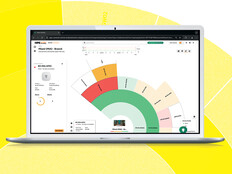Feds Use SDN to Support Scientific Research
Scientific data sets are getting so large they’re becoming difficult to share and move.
The National Science Foundation supports numerous research programs studying software-defined networks (SDNs). The agency’s work with what’s known as a Science DMZ — a science-optimized section of a network that’s partially protected from the larger Internet, with controlled access to an organization — may pave the way for many other scientific breakthroughs.
Bryan Lyles, program director for NSF’s Division of Computer and Network Systems, says to create a Science DMZ, universities and other government agencies must deploy an SDN controller at the edge of their network that connects to high-performance research and education networks.
“The idea is to use an SDN network to transfer terabytes, or even petabytes, of data that are used in scientific research,” Lyles explains. “Think of it as a large file transfer that runs over a dedicated circuit, but it’s moving enormous amounts of data.”
Lyles says NSF funds experimental work that will expand the applicability of Science DMZs, including one at the University of Utah, where researchers are testing ways to build a dynamic set of computational data that can go directly down to the desktop over an SDN. The research uses NSF’s Global Environment for Network Innovations (GENI) software-defined infrastructure framework, which redefines the meaning of the “edge of the campus.”
The percentage reduction in time that organizations can expect for provisioning network services with SDN
SOURCE: Gartner, “Beyond the Hype: SDN Delivers Real-World Benefits in Mainstream Enterprises” October 2014
Andrew Lerner, a research director for Gartner, says software-defined networks (SDNs) can help IT departments run more agile networks that are easier and less expensive to manage, but the technology’s real potential lies in its ability to set up the network as a center of innovation.
“There’s great potential for the networking market to innovate in a similar manner to smartphones, where IT departments set up a central SDN controller and run apps for functions such as authentication and security,” Lerner explains. “Whether that happens in the next three to five years is not clear right now, but the potential is there.”
High Energy for SDN
Inder Monga, chief technology officer for the Energy Sciences Network (ESnet) run by the Department of Energy, says some of the national labs have already set up well-activated Science DMZs.
Monga says the ability to move large data sets between government research institutions and universities has become very important as scientists collaborate across institutions to tackle global science challenges such as climate change and finding new energy sources.
“Historically, DOE has supported collaborative research by teams at universities and national labs, and the concept of Science DMZs grew out of the need to handle the increasingly massive data sets created by these teams,” says Monga. “As experimental facilities deploy more precision cameras and sensors, there is a great deal of interest and effort in setting up Science DMZs at more national labs.”
Most of the NSF-funded Science DMZs start by setting up an SDN controller in a testbed where it can run a variety of network applications. While some labs may opt for open-source products, Monga says the industry needs a strong ecosystem of both commercial and open-source products.
“While we may use commercial controllers, we expect to develop our own networking apps,” Monga says, adding that some of the apps under development include multipoint virtual private networks, dynamic provisioning and security and policy applications.









